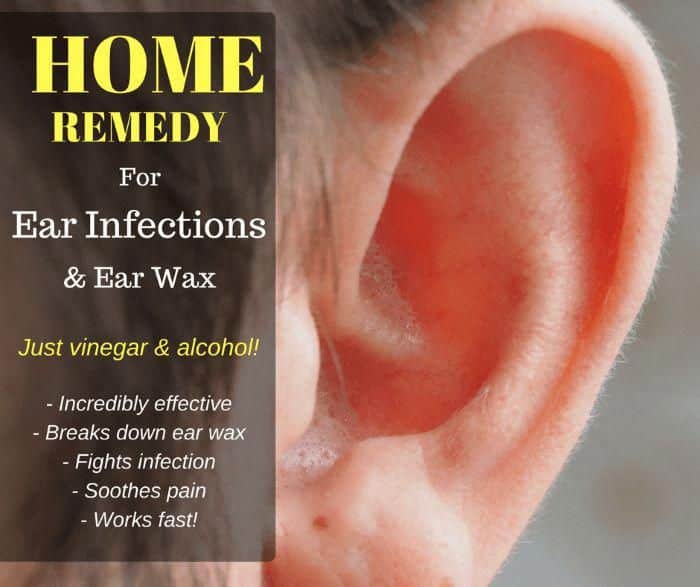Who Is Most Likely To Get An Ear Infection
Middle ear infection is the most common childhood illness . Ear infections occur most often in children who are between age 3 months and 3 years, and are common until age 8. Some 25% of all children will have repeated ear infections.
Adults can get ear infections too, but they dont happen nearly as often as they do in children.
Risk factors for ear infections include:
- Age: Infants and young children are at greater risk for ear infections.
- Family history: The tendency to get ear infections can run in the family.
- Colds: Having colds often increases the chances of getting an ear infection.
- Allergies: Allergies cause inflammation of the nasal passages and upper respiratory tract, which can enlarge the adenoids. Enlarged adenoids can block the eustachian tube, preventing ear fluids from draining. This leads to fluid buildup in the middle ear, causing pressure, pain and possible infection.
- Chronic illnesses: People with chronic illnesses are more likely to develop ear infections, especially patients with immune deficiency and chronic respiratory disease, such as cystic fibrosis and asthma.
- Ethnicity: Native Americans and Hispanic children have more ear infections than other ethnic groups.
What To Do If You Get An Ear Infection
While ear infections are common in children, they can also occur in adults. Symptoms can be uncomfortable and even painful. Here are some simple ways to know if you may have an ear infection and how to reduce your risk.
Types of ear infections
There are three types of ear infections: outer ear infection, middle ear infection and inner ear infection. Ear infections can be caused by bacterial, fungal or viral infections.
Some people are more prone to ear infections because they have small eustachian tubes in the ears or their tubes dont have a steep enough slope. Smoking, being exposed to secondhand smoke, having a cold or respiratory illness, or having seasonal or year-round allergies can also increase your risk of an ear infection.
Outer ear infection: Also known as swimmers ear or otitis externa, an outer ear infection typically begins as an itchy rash. It can occur when water stays in the ear after you bathe or swim. This moisture can allow bacteria to grow. Another common cause of outer ear infections is when the outer lining of the ear is irritated, usually by scratching or putting your fingers or cotton swabs in your ears.
Symptoms of an outer ear infection include itchiness, clear and odorless drainage, muffled hearing, ear pain, swelling, redness or tenderness.
How to prevent ear infections
How to treat ear infections
When to seek medical care
Jamie Anthony is a primary care physician at Pardee Fletcher Medical Associates.
Home Remedies For Toddler Ear Infections
Ear infections are common in children. Five out of six children will have at least one ear infection by the time they are three years old, and ear infections are the most common reason for childhood doctors visits.
Common signs of ear infections in children include:
- Trouble hearing or responding to sounds
- Clumsiness/problems with balance
- Fluid draining from the ear
Because of concerns surrounding antibiotic resistance, many doctors are avoiding prescribing antibiotics for ear infections unless absolutely necessary.
Treatment is usually more focused on pain relief, which can be managed effectively at home in most cases.
Also Check: Yeast Infection Over A Month
Apple Cider Vinegar With Rubbing Alcohol Ear Drops
This recipe is identical to the one above except it involves rubbing alcohol instead of warm water.
Rubbing alcohol is both antimicrobial and antibacterial. Do not use this method if you have drainage from your ear or think you may have a middle ear infection. Also, do not continue with this mixture if you have any stinging or discomfort when using these drops.
- Mix equal parts apple cider vinegar with rubbing alcohol .
- Apply 5 to 10 drops in each affected ear using a clean dropper bottle or baby syringe.
- Cover your ear with a cotton ball or clean cloth and lean on your side to let drops enter and sit in the ear. Do this for about 5 minutes.
- Repeat this application as often as desired to fight ear infection.
It’s Not Possible To Prevent Middle Ear Infections

It’s not possible to prevent middle ear infections. There are some things you can do that may reduce your child’s risk of developing the condition. These include:
- make sure your child is up-to-date with their routine vaccinations
- avoid exposing your child to smoky environments
- consider avoiding using a dummy, or reducing use – use of a dummy is associated with more ear infections
- don’t feed your child while they’re lying flat on their back
- breastfeeding reduces the risk of infections
Avoiding contact with other children who are unwell may also help reduce your child’s chances of catching an infection that could lead to a middle ear infection.
You May Like: Urinary Tract Infection Without Antibiotics
When To Call A Doctor
While home remedies are often all that is needed for a childs ear infection, a visit to a healthcare provider may be necessary.
- They are under six months of age
- They are under three months of age and have a temperature of 100.4°F or higher
- They have a fever of 102.2°F or higher
- Symptoms last longer than two to three days or get worse
- Symptoms are severe
- Your child snores while asleep
- You think your child needs to be seen
Your childs healthcare provider may want to see the child even if home remedies seem to be working.
Fungal Ear Infection Symptoms
A fungal infection in your ear canal will generally result in one or more of the following symptoms:
- Painful or itchy ears
If your baby is less than 2 years old, watch out for these symptoms:
- Fever: An ear infection may cause a mild fever or no fever at all.
- Pain or fussiness: A baby with an ear infection may rub at his ears, cry inconsolably or be unusually fussy.
- Redness or swelling: The outside of the pinna may appear red and swollen.
- Sleep problems: A baby with an ear infection might be sleeping fitfully because hes uncomfortable.
If you have any of these symptoms, visit your doctor to determine if you have a fungal ear infection and what treatment options are available.
You May Like: Connect Phonak Hearing Aids To Iphone
Recommended Reading: Can Ketoconazole Treat Yeast Infection
Prevention Of Middle Ear Infection
Many children who get recurrent ear infections have grommets put into their eardrums to prevent infection. Grommets are special ventilating tubes that stop fluid from building up behind the eardrum and help preserve hearing. If your child needs grommets, hell see an ear, nose and throat specialist.
Avoid smoking. Children who are exposed to second-hand smoke are more likely to develop a range of illnesses, including middle ear infections.
Home Remedies For Ear Pain
Before antibiotics, parents used home remedies to treat the pain of ear infections. Now, with current concern over antibiotic overuse, many of these simple remedies are again popular:
- Parents can press a warm water bottle or warm bag of salt against the ear. Such old-fashioned remedies may help to ease ear pain.
- Due to the high risk of burns, ear candles should not be used to remove wax from ears. These candles are not safe or effective for treatment of ear infections or other ear conditions.
- Researchers are studying the protective value of probiotics especially lactobacilli strains such as acidophilus. But it is important not to give your child any herbal remedies or dietary supplements without consulting with the pediatrician.
Read Also: How To Diagnose Viral Infection
What Natural Or Home Remedies Soothe And Provide Earache Pain Relief
Earaches may often be treated at home. The goal is to decrease inflammation and pain.
You May Like: How To Turn On Hearing Aid Mode On Iphone
Can You Prevent Ear Infections
Because colds are very infectious and easily spread among children, it can be very hard to prevent your child from getting sick. However, there are risk factors you can control:
- Limit your childs exposure to secondhand smoke
- Make sure your childand youare vaccinated against the flu every year
- Follow good hygiene habits, like frequent handwashing and using hand sanitizer
- Teach your child to cough into her elbow, not her hands
You May Like: Sign Language Hungry
Read Also: How To Get Yeast Infection Pill
Can Ear Infections Affect Hearing
Fluid buildup in the middle ear also blocks sound, which can lead to temporary hearing problems. Kids having a problem might:
- not respond to soft sounds
- need to turn up the TV or radio
- seem inattentive at school
In kids who have otitis media with effusion, the fluid behind the eardrum can block sound, so mild temporary hearing loss can happen, but might not be obvious.
A child whose eardrum has ruptured might have ringing or buzzing in the ear and not hear as well as usual.
How Does The Eustachian Tube Change With Age

As a person ages, the Eustachian tube doubles in length and becomes more vertically positioned so that the nasopharyngeal orifice in the adult is significantly below the tympanic orifice than in a child.
The greater length and particularly the slope of the tube as it grows serves more effectively to protect, aerate and drain the middle ear.
Also Check: Over The Counter Kidney Infection Medicine Ireland
Earache Remedies You Can Try
1. Hot or cold compress
The skinny: Grab an ice or heat pack and put it onthe affected ear to help with the pain.
Doctors advice: The temperature you use is up to you. Wrap it in a towel tomake sure its not too cold or too hot. You dont want to cause any burns.
2.Over-the-counter pain relievers
The skinny: Pain relievers work as advertised, helping take the edge off the pain.
Doctors advice:Both adults and kids can rest easier when they take acetaminophen or ibuprofen at the right dosage. These medications reduce pain and fever, making you feel more comfortable.
3. Sleep position
The skinny: How you sleep can affect ear pain. Rest with your head on two or more pillows, so the affected ear is higher than the rest of your body. Or if the left ear has an infection, sleep on your right side. Less pressure = less ear pain.
Doctors advice: It could be effective, though a few inches may not make a big difference in pressure measurement. But if it makes you feel better, go for it.
Donât Miss: How To Say Sorry In Sign Language
Where Is The Middle Ear
The middle ear is behind the eardrum and is also home to the delicate bones that aid in hearing. These bones are the hammer , anvil and stirrup . To provide the bigger picture, lets look at the whole structure and function of the ear:
The ear structure and function
There are three main parts of the ear: outer, middle and inner.
- The outer ear is the outside external ear flap and the ear canal .
- The middle ear is the air-filled space between the eardrum and the inner ear. The middle ear houses the delicate bones that transmit sound vibrations from the eardrum to the inner ear. This is where ear infections occur.
- The inner ear contains the snail-shaped labyrinth that converts sound vibrations received from the middle ear to electrical signals. The auditory nerve carries these signals to the brain.
Other nearby parts
- The eustachian tube regulates air pressure within the middle ear, connecting it to the upper part of the throat.
- Adenoids are small pads of tissue above the throat and behind the nose and near the eustachian tubes. Adenoids help fight infection caused by bacteria that enters through the mouth.
Read Also: What Essential Oil Is Good For Tooth Infection
Safe And Effective Ways Treat A Middle Ear Infection
This article was co-authored by Laura Marusinec, MD. Dr. Marusinec is a board certified Pediatrician at the Childrens Hospital of Wisconsin, where she is on the Clinical Practice Council. She received her M.D. from the Medical College of Wisconsin School of Medicine in 1995 and completed her residency at the Medical College of Wisconsin in Pediatrics in 1998. She is a member of the American Medical Writers Association and the Society for Pediatric Urgent Care.There are 15 references cited in this article, which can be found at the bottom of the page. This article has been viewed 518,314 times.
Middle ear infections are fairly common in childhood. One of every 10 children will experience otitis media, the medical term for middle ear infection, every year. This is 10 times the number of adults who will suffer from a middle ear infection.XResearch source Otitis media is the second leading cause of doctors visits in children and and the most frequent reason for antibiotic prescription in children.
When To See Your Doctor
See your doctor if your child:
- Is six months of age or younger
- Has a high fever or bad earache
- Has an ear discharge that lasts more than 24 hours
- Continues to have fever or bad earache two days after they start treatment
- Still seems to have trouble hearing after six to eight weeks
- Seems to be getting worse or you are worried at any time.
You May Like: Antibiotic Cream For Ear Infection
Treating Middle Ear Infections
Mild cases of infection can be treated quickly with paracetamol . Do not give regular paracetamol medicine for more than 24 hours without seeking advice from your doctor. It will help if you raise the head of your child’s bed.Some middle ear infections lead to the condition known as glue ear, when thick fluid in the middle ear causes slight deafness. This is not permanent, but it may need treatment. This can include antibiotics and surgery to insert pressure-equalising tubes in the ear drums. Children with glue ear usually recover in a few weeks after the fluid has drained away.
Can Middle Ear Infections Be Prevented
It’s not possible to prevent middle ear infections, but there are some things you can do that may reduce your child’s risk of developing the condition. These include:
- make sure your child is up-to-date with their routine vaccinations particularly the pneumococcal vaccine and the DTaP/IPV/Hib vaccine
- avoid exposing your child to smoky environments
- don’t give your child a dummy once they’re older than six to 12 months old
- don’t feed your child while they’re lying flat on their back
- if possible, feed your baby with breast milk rather than formula milk
Avoiding contact with other children who are unwell may also help reduce your child’s chances of catching an infection that could lead to a middle ear infection.
You May Like: Swelling Mouth From Tooth Infection
What Are The Symptoms Of Otitis Media
Symptoms of ear infection include:
- Ear pain: This symptom is obvious in older children and adults. In infants too young to speak, look for signs of pain like rubbing or tugging ears, crying more than usual, trouble sleeping, acting fussy/irritable.
- Loss of appetite: This may be most noticeable in young children, especially during bottle feedings. Pressure in the middle ear changes as the child swallows, causing more pain and less desire to eat.
- Irritability: Any kind of continuing pain may cause irritability.
- Poor sleep: Pain may be worse when the child is lying down because the pressure in the ear may worsen.
- Fever: Ear infections can cause temperatures from 100° F up to 104° F. Some 50% of children will have a fever with their ear infection.
- Drainage from the ear: Yellow, brown, or white fluid that is not earwax may seep from the ear. This may mean that the eardrum has ruptured .
- Trouble hearing: Bones of the middle ear connect to the nerves that send electrical signals to the brain. Fluid behind the eardrums slows down movement of these electrical signals through the inner ear bones.
When Should I Talk To A Doctor About An Ear Infection

If the ear infection symptoms dont improve within a few days, make a primary care appointment. Other signs that its time to see a doctor include:
- Ear pain that lasts more than two days
- Fluid draining from the ear
- Changes or loss of hearing
- Fever over 102 degrees Fahrenheit
- Frequent or recurrent ear infections
You May Like: Strep Throat And Ear Infection Medication